All you need to know about your products!

| 3DNews Vendor Reference English Resource - All you need to know about your products! |
||||||
 |
||||||
|
|
||||||
Computex`2004: Mobo FoxconnAuthor:Date: 01/06/2004 Computex`2004: Asustek's Expo StandAt the expo stand of Asus, the central place is taken by a car engine with nitrogen protoxide injection. 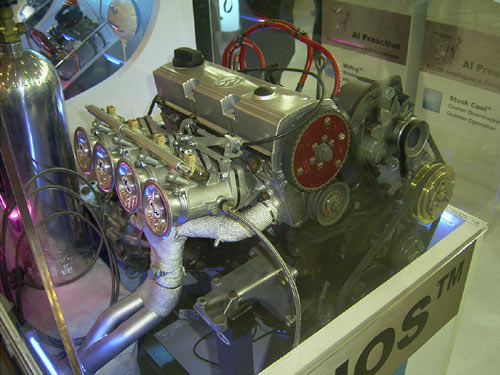 In fact, this doesn't mean the company started manufacturing cars for street racing. Actually, the audience were shown a new proprietary technology - AI NOS (tm), aimed at boosting system performance. Despite the nice name, AI NOS is in fact just another implementation of "dynamic overclocking". That is, as more load is applied to the processor, the motherboard overclocks the processor (and raises the memory operating frequency). The first board that supports this feature is P5GD2 Premium. 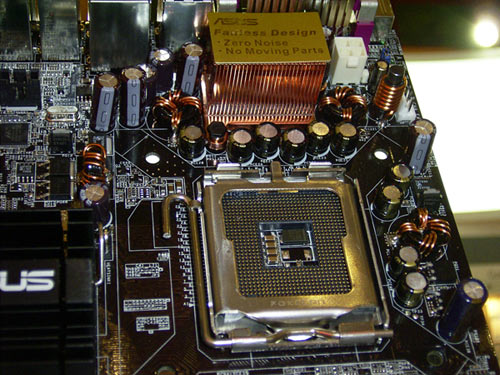 ASUS P5GD2 Premium Here are the brief specifications:
Note separately that the company offers the new "Premium" line in its assortment. So far, Asus boards have ranked as "-X" and "Deluxe". So, by the set of features and supported technologies (as well as package bundles) boards of the "Premium" series will surpass the "Deluxe"! For example: the P5GD2 Deluxe board offers only one Gigabit controller, lacks support for Firewire-800. Besides, it offers scarcer package bundle (as compared to the "Premium" :) The specific feature of the P5GD2 line is the cooling system for the power supply module (the technology acquired the name Asus Stack Cool). 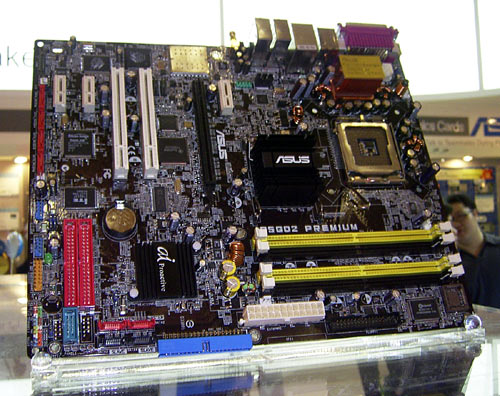 The system is fully noiseless, since it lacks a fan (evidently, air flow from the processor cooler is used). Besides P5GD2, the Stack Cool is installed on the following boards: 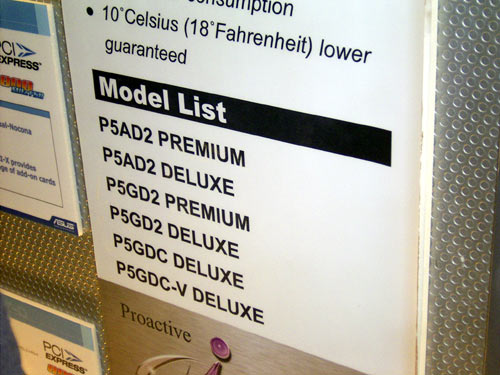 As we see, all the board names are absolutely unknown. To put the impressions from the large number of models in order, let's bring in the following table:  As is seen from the table, boards P5AD Premium/Deluxe rank higher since they are built on the Intel 925X chipset. 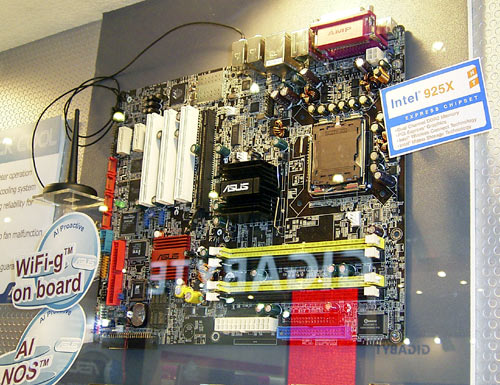 In practice, this results in higher performance level (due to the PAT technology). Along with these, the Intel 925X chipset theoretically differs from i925 (even more from i915P) in the support of the speedier system bus (1066 MHz). However, all the materials state that supported are processors with the maximum bus speed = 800 MHz. Evidently, announcement of support for the 1066 MHz bus takes place after the relevant statement by Intel. There are two more boards of interest - P5GDC Deluxe and P5GD1 (both based on the i915P chipset). The specific feature of P5GDC Deluxe is simultaneous support for both DDR and DDR2 memory. 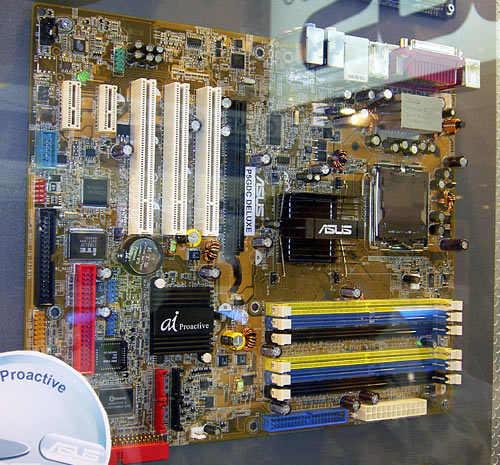 Note the number of DIMM slots - as many as six. As regards the P5GD1 board, it is ideal for users who use high-quality DDR memory and intend to use it with LGA775 processor. 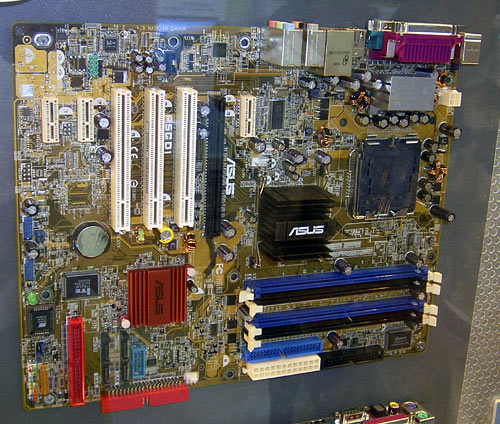 Besides Intel systems, boards for various Athlon64 processors were found at the company expo stand. Of most interest is the A8V Deluxe motherboard built on the VIA K8T800Pro chipset plus VT8273 with the most promising Socket939. 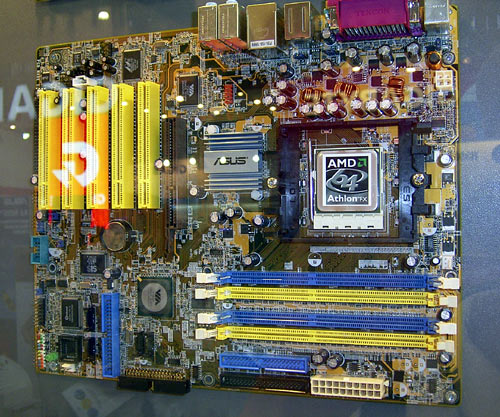 Another motherboard for the Socket939 is A8N-E Deluxe based on the nVidia CK804 chipset. But Socket 939 motherboards will become more attractive once the relevant processors hit the retail in mass quantities (preferably at affordable prices). For now, there are only Socket 754 processors on the market. For these processors, Asus released the K8N-E (DELUXE) motherboard built on the nForce3 250 chipset. 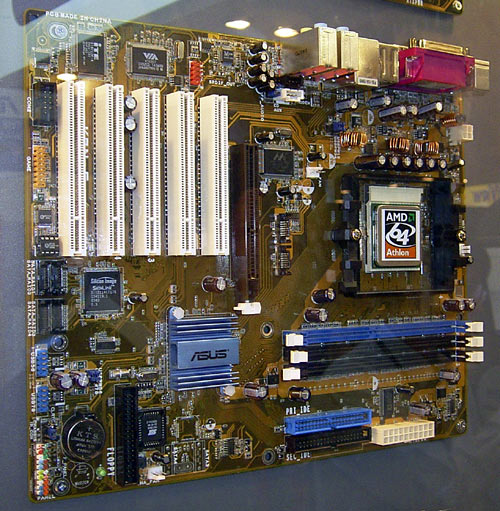 Apart from motherboards, almost all the produce assortment was presented at the expo. In particular, let's look at the photos of two most attractive barebone systems: 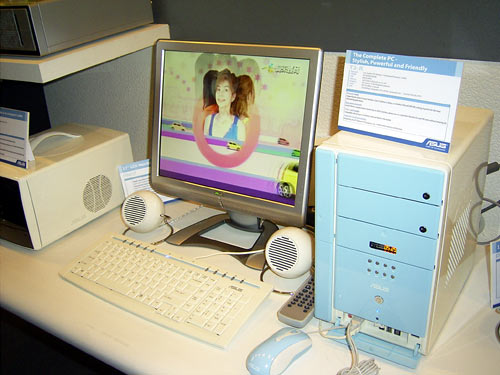 the T2-R model assembled with a motherboard on the ATI RS300 chipset + IXP200, 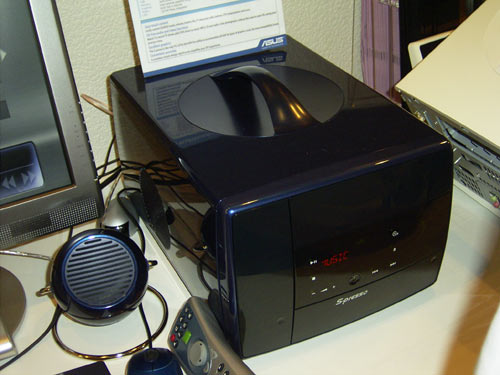 and the S-presso model using a motherboard on the i865G chipset +ICH5. Note that the barebone systems are at the expo with LCD monitors manufactured by Asus itself.  The fast emergence of the company on the LCD monitor market can be explained by that Asus was provident and acquired an ECS factory operating in the respective field. What's more, production lines were upgraded, and now the company representatives can boast shorter response times in these monitors - merely 16 ms. We finally got round to coolers. That is the smallest and the most noisy computer component. But this specimen disproves each of the statements. 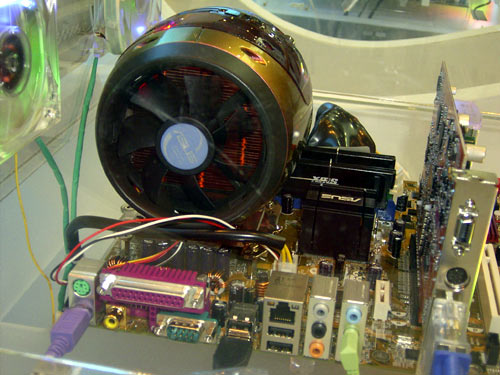 One more photo on the side: 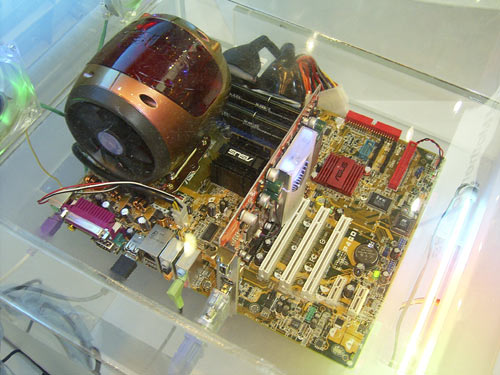 We start reviewing the Epox expo with the 8RDA6+ board built on the nForce2 Ultra400 chipset, plus the long-expected Gigabit MCP south bridge. 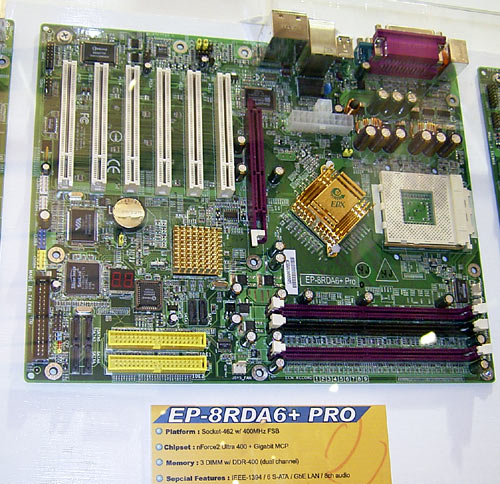 Therefore, the board acquired support for 6 channels of SerialATA (4 channels - additional controller, with 2 channels integrated into the south bridge). There also appeared integrated support for Gigabit network connection. On the other hand, the fast APU SoundStorm, so popular for the quality audio, is missing in the Gigabit MCP. The light version of 8RDA6+ that lacks additional controllers was dubbed 8RDA+ Pro.  Therefore, Epox engineers carried the integration of 8RDA+ and 8RDA3+ lines to completion. As regards the Athlon64 platform in the Socket 754 platform, the 8KDA3+ motherboard was of most interest to the spectators. 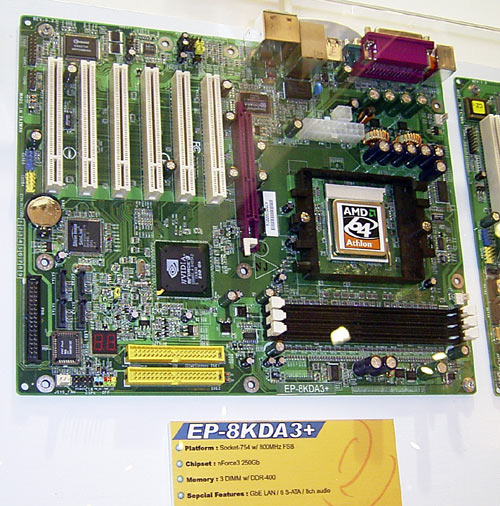 But our readers must have read the detailed roundup of this motherboard by now. So let's take a closer look at motherboards for the next generation of Athlon64 Socket939 processors. First, it is the Epox 9NPA+ model built on the nVidia CK804 chipset. 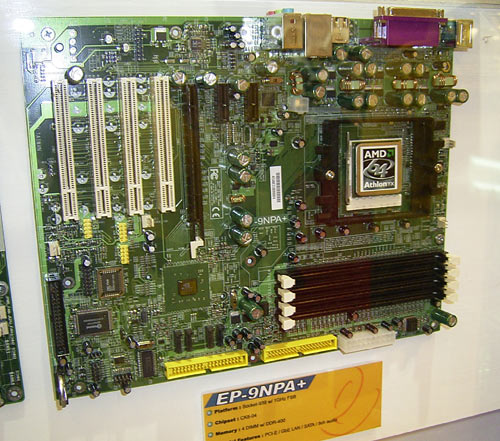 The radiator had been removed from the chipset, so we were able to take a picture of that. 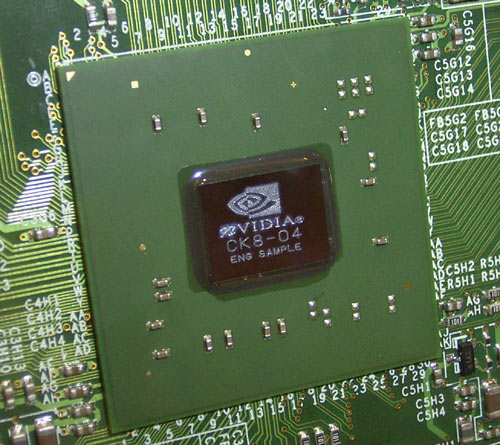 Of note is support for PCI Express boards (one 16x slot plus two 1x slots). For users who aren't going to replace their expensive AGP video card with the PCI Express version, Epox offers the 9NDA+ board built on the nForce3 Ultra chipset. 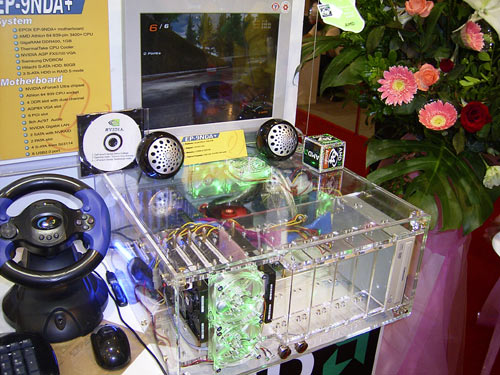 The board offers support for Athlon64 Socket939 processors, as well as AGP8X video cards. Now let's turn to Epox boards aimed at Intel Pentium4 processors. Among the boards built on the most powerful i925X chipset, was 5LWA+. 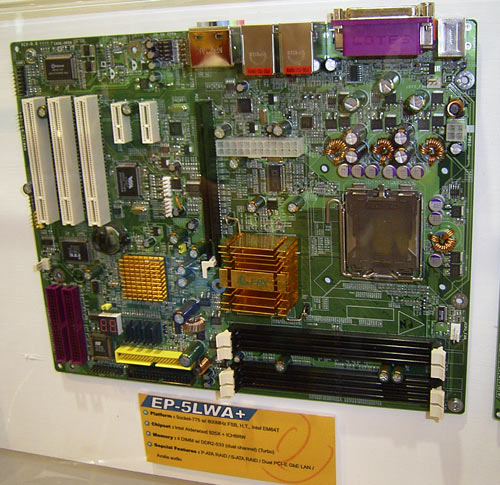 ICH6R is used as the south bridge chip. The chips is also used for 5EPA+ and 5EPA2+ motherboards. Both boards offer practically the same design and specifications. The differences are only in the type of supported memory: 5EPA2+ supports DDR2, and 5EPA+ supports DDR. 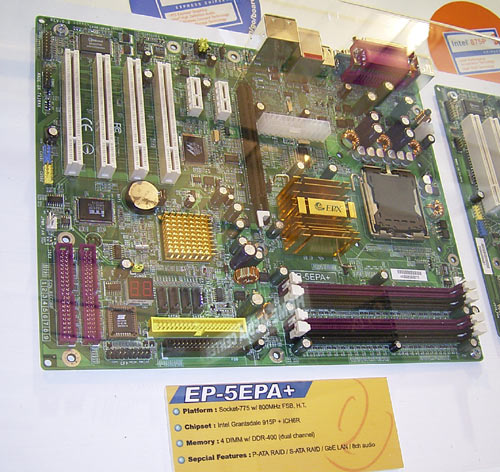 Epox 5EPA+ 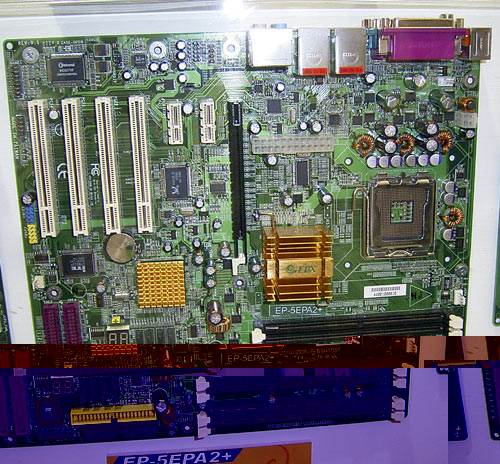 Epox 5EPA2+ Another interesting motherboard is Epox 4EGA+ built on the i915G chipset (with an integrated video core) + ICH6 south bridge. 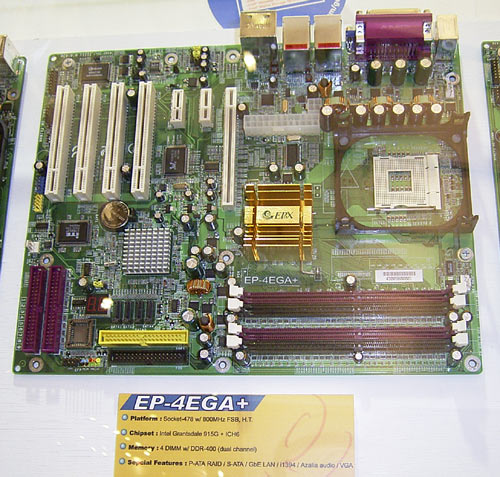 Epox 4EGA+ The specific feature of this board is that it is aimed at Pentium4 Socket478 processors. The last today is Epox 4PCI2E, a motherboard built on i875P chipset and is aimed at industry computers. 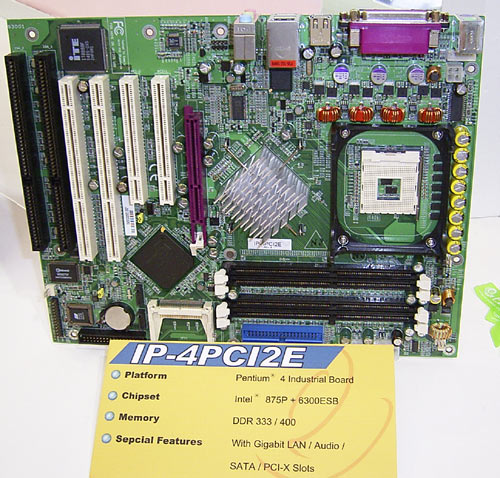 Epox 4PCI2E One of the features of the board is support for ISA and PCI-X slots. Let's now smoothly turn to the expo site where barebone systems are exhibited. 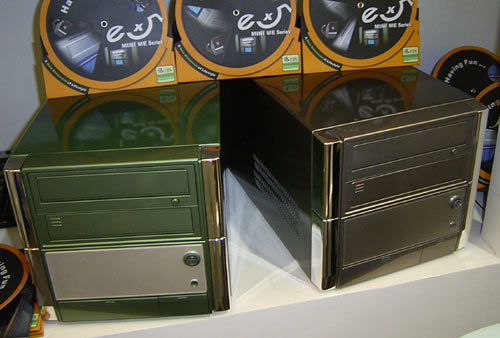
The first two are absolutely standard cubes which every company already has in the assortments. 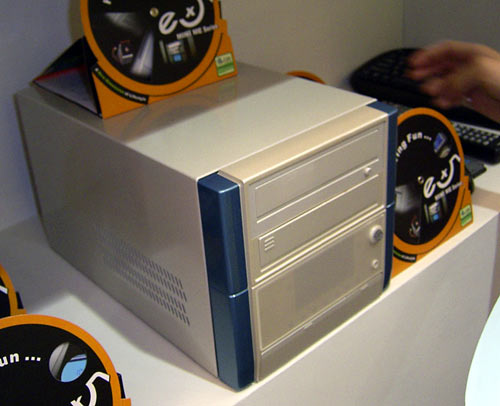
The next "barebone" boasts really impressive design whose spice is in the fold-up front panel and an additional LCD screen. 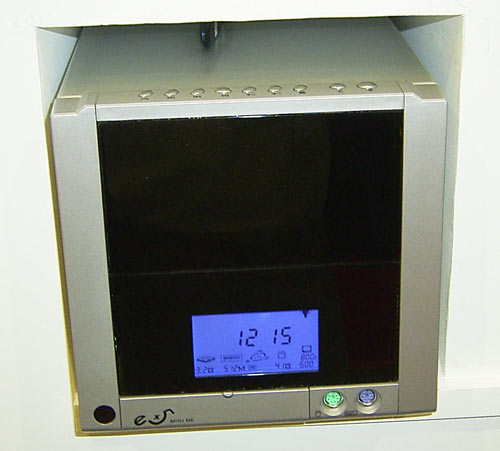
The panel folds up very smoothly thus giving access to 5" compartments. Just another pair of absolutely standard barebones with transparent side walls. 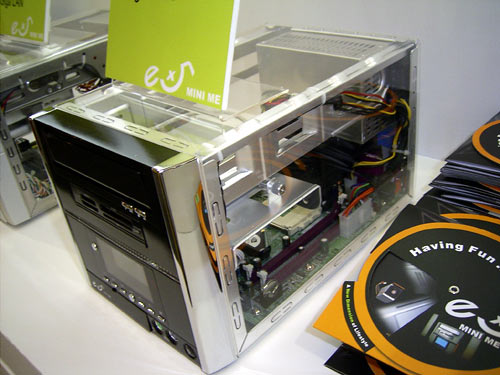
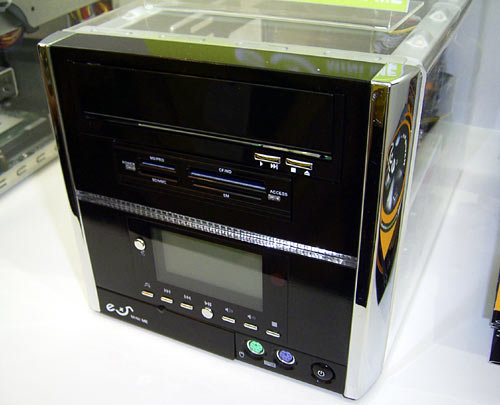
Here are the last photos taken at the Epox expo stand - various Bluetooth devices: keyboard, mouse, 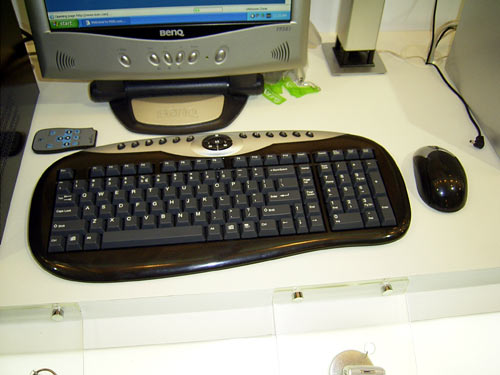
and speakers. 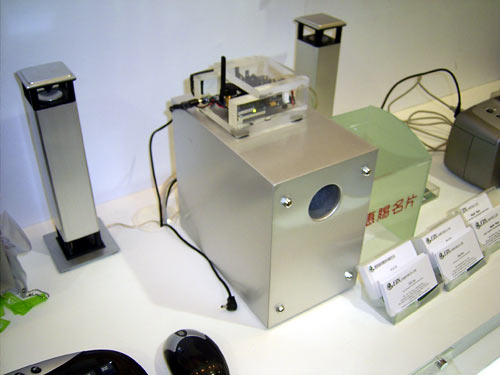
Motherboards built on new Intel chipsets take the foreground at the company's expo stand. 8ANXP-D on the i825X chipset +ICH6W is the flagship. 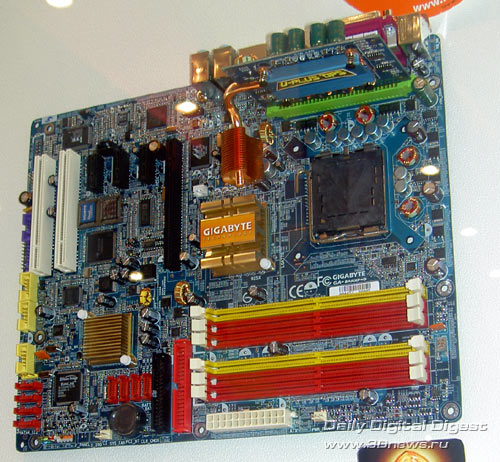 Gigabyte 8ANXP-D It was also installed in the demo system. 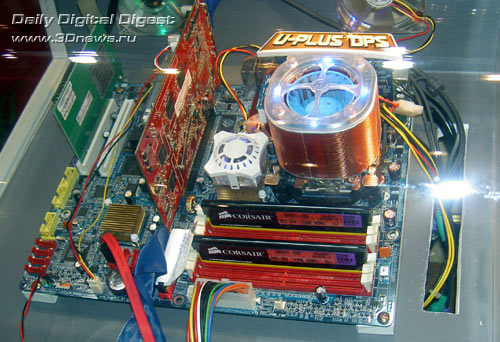 The board features in the reviewed version of additional power supply module dubbed Ultra-DPS 2 (the previous version was called DPS). 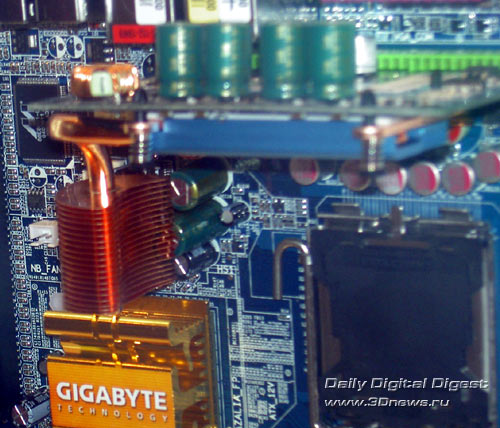 the U-DPS 2 module on the 8GPNXP Duo motherboard Besides, the board offers exceptional expansion options: six DDR2 400/533 slots and eight SerialATA channels. Also, the U-DPS 2 module is fitted on the 8GPNXP Duo motherboard built on the i915P chipset, and stands out with simultaneous support for DDR2 memory (4 slots) and DDR(2 slots). 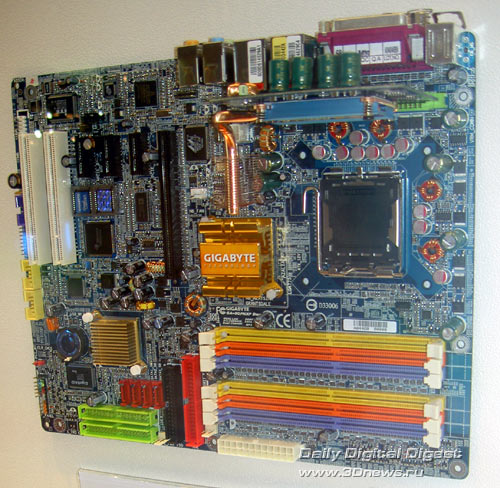 Gigabyte 8GPNXP Duo Remember that the i925X chipset supports only the DDR2 memory, whereas the i915P(G) supports only DDR2 and DDR. The company engineers made use of the chipset specifics in developing the 8i915P Duo Pro motherboard: two DIMM slots are intended for the DDR, with two more for the DDR2. 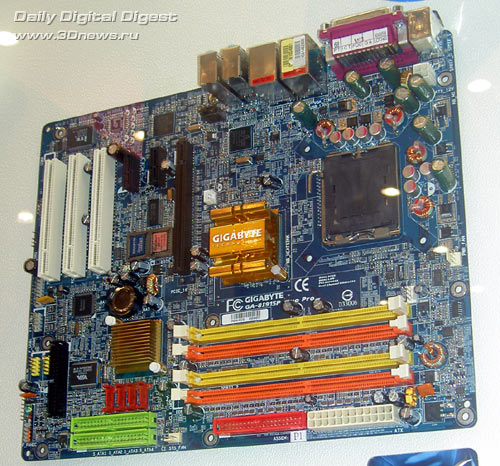 Gigabyte 8i915P Duo Pro To accentuate the feature, Gigabyte used the DUO suffix in the name. Also note that the board is aimed at the middle-end sector of the market. Therefore, to make the product cheaper, they removed support for DPS2 and left only four DIMM slots as is: two for DDR2 and two for DDR. The next board 8i915P Duo is based on the same i915P chipset and used the same PCB. 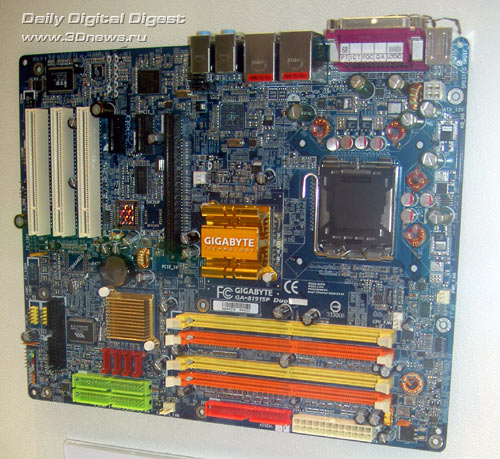 Gigabyte 8i915P Duo Reduction in the number of controllers is another step towards the reduction of prices. In particular, one Gigabit controller has been removed, with the support for proprietary DualBIOS technology disabled. The next board is dubbed 8i915P-D Pro and is meant solely for use with the DDR2 memory. 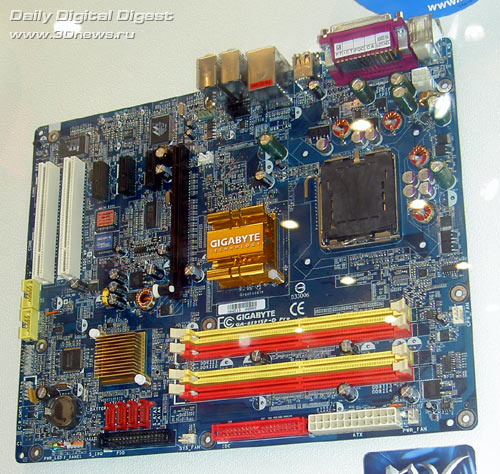 Gigabyte 8i915P-D Pro The other board 8i915P Pro does not support DDR2, but is aimed at DDR only. 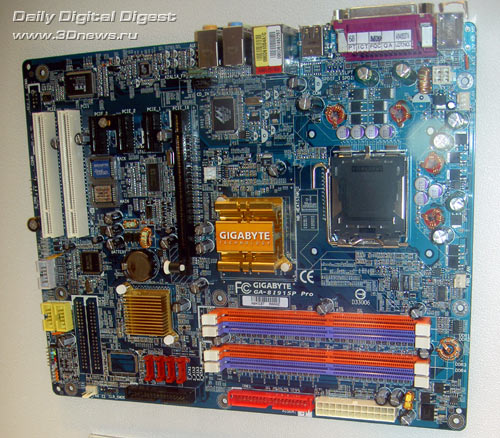 Gigabyte 8i915P Pro Gigabyte presented one more board on the same PCB - 8i915G Pro which is based on the i915G chipset (with integrated video core). 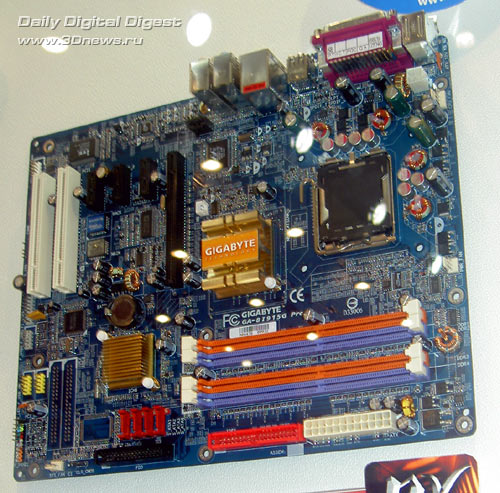 Gigabyte 8i915G Pro This board also supports DDR only. For users interested in support for the DDR2 plus integrated graphics core, the company offers the 8i915G-D Pro motherboard. 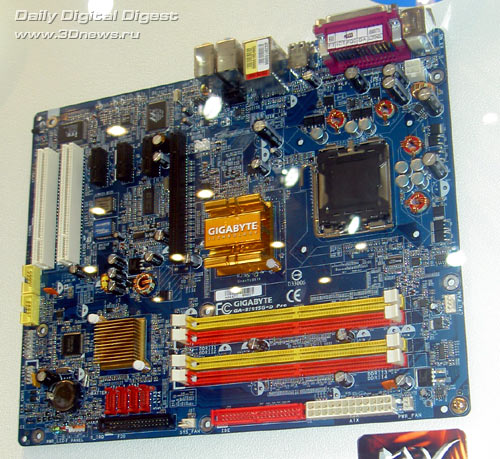 Gigabyte 8i915G-D Pro It turns out that the need for support of two memory types at a time makes manufacturers duplicate the lines of their produce. Moreover, most users who plan a quick migration to LGA775 processors need cheap solutions. That is why Gigabyte presented quite an interesting motherboard: 8IPE775 Pro which is based on somehow outdated (albeit cheaper) i865PE chipset. 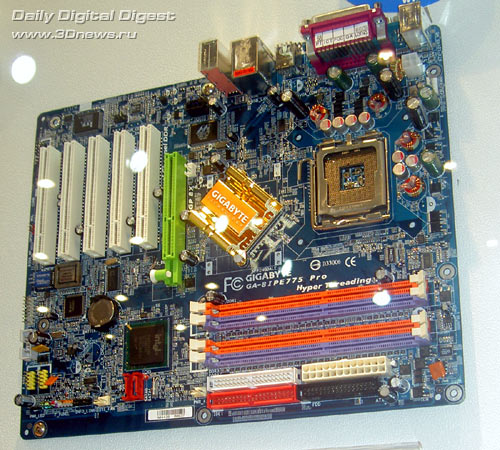 Gigabyte 8IPE775 Pro Now let's look at the motherboards aimed at AMD processors. First off, it is the K8NSNXP board based on the nForce3 250 chipset aimed at Socket754 processors. 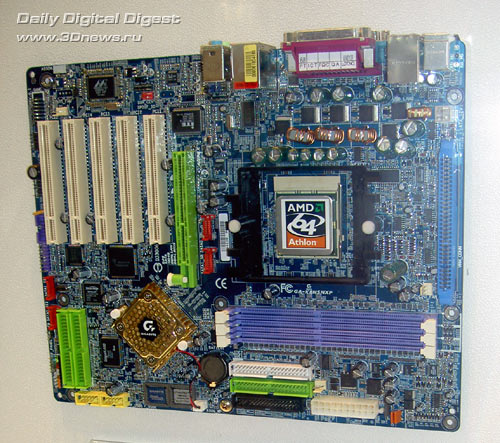 Gigabyte K8NSNXP This board has already been tested in our lab, and soon we'll publish a review. But the urgency of this socket is already coming to naught, and Socket 939 is becoming the most attractive buy for Athlon64 processors with a dual-channel memory controller. Anyway, Gigabyte met the release of new AMD processors fully armed. In particular, it is K8NSNXP-939 on the nForce3 250 chipset. 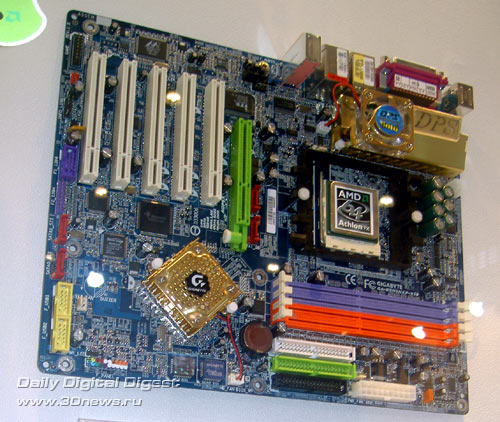 Gigabyte K8NSNXP-939 The next board is also based on the nVidia - CK-804 chipset. The model is called K8NENXP-939. 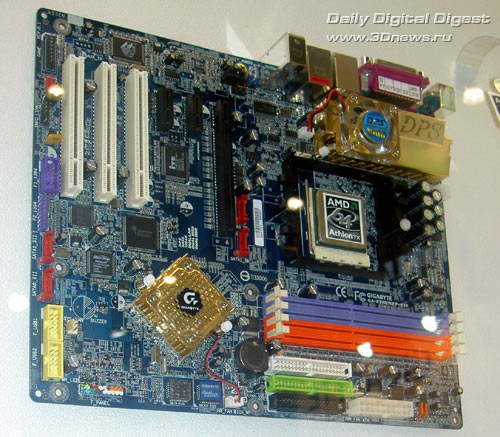 Gigabyte K8NENXP-939 The board offers one PCI Express x16 slot for video cards, two PCI Express x1 slots and three regular PCI slots. Reminding it that it's just the CK-804 chipset is the first nVidia product in which support for the PCI Express bus was implemented. Besides, one more board is also aimed for Athlon64 Socket939 processors but is based on the VIA K8T800 Pro chipset. 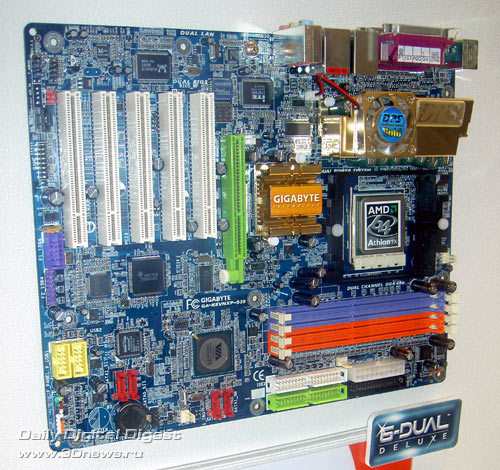 Gigabyte K8VNXP As regards the low-end market, Gigabyte released a new series of boards dubbed RZ to conquer it. 7NF-RZ based on the nVidia nForce 2 Ultra 400 chipset is a typical representative of the series. 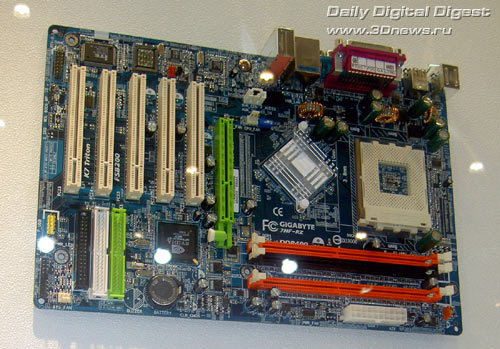 Gigabyte K8VNXP Now about the coolers: the successful launch of 3D Cooler resulted in that Gigabyte started rubber-stamping clones. The SuperSilent model with reduced turbine rotational speed (thus, reduced noise) was released. And right at the expo, the Ultra Silent model was presented (probably of even lower noise level). 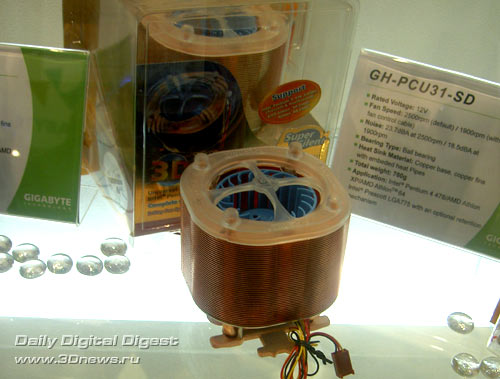 Gigabyte Ultra Silent Next to it, there were two versions of the fastening frame for the LGA775 socket: a standard version of rigid black plastic, 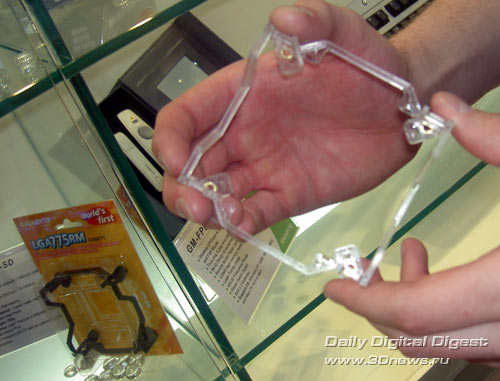
and the stronger one (as well as flexible) made of transparent material. The video topic merits a separate thorough review, se we are currently preparing a vast coverage of all the novelties presented at Computex`2004, including all solutions by Gigabyte. Video cards is the most perishable stuff in the system. Their generations are flickering past so quickly that you even can't get used to them and get bored. Those were really fabulous times when the "Ti" line ruled the whole world..But one morning the ATI gang knocked up and brought us the young Radeon9700Pro cutie-beauty for breakfast.. Then for lunch - a gangbang with NV35/38 lady butterflies and R350/360 monsters. Completely exhausted by the evening, the consumer anyway indulges with the NV40 mermaid (nicknamed GeForce 6800) waving her tail and striving to kick out your jaw if things go wrong.. Then - R420 (Radeon X800, or simply call her "Ruby")... "Did you order more girls? Here they are." Ugh! Bugged to death!! Each of them wants $500 in cash and now, seducing us with their unexampled voluptuous shapes made with version 2 pixel shaders and splendid hair with version 3, plus the "untiring performance". Can one really resist the temptation? No! So, you pin all the butterflies on the needle and hang them on the wall to join those rejected and deserted. For the coming six months to one year - only lady spies and mermaids in your heart, with financial disaster in your wallet. Ladies wouldn't have been the way they are if they first don't drive us crazy. At that, you've got to go through the "we aren't like them - we are different" procedure. They urge you for a strip-tease show called "presentation", otherwise no one can tear us - lazy guys - away from the computer. Presidents, vice-presidents, marketing directors walk along the podium, showering praise upon the goods in every possible way - as it should be. The cuties are still behind the scenes - not yet ready. One of them is so swelled that even can't fit into any dress and is carrying a mini power station behind. The other is always annoyed about the ever falling make-up. By the end of the show, the sacred phrase "will be available in two weeks.." is pronounced, with the spectators slowly drifting apart over to bars, gulping the saliva, moaning with lust, wiping male tears from the forehead.. Every spectator is duped, carrying a pound of strings on the ears. We know it quite well - there are as few top-notch chips as really beautiful ladies. So few that they can't be quickly produced in quantities enough to emulate their abundance on the market and small shops. See something flicker in the distance? - that's all.. enjoy having seen it out of the corner of your eye and be happy! But if you happen to get the privilege of the first touch, legends and sagas of that memorable day will be passed over to your grandchildren, exciting their minds. The creators are easy to understand - the chip is there, as many as eight first live chips brought from the factory by a special flight in a panzer handbag, and the cards built on the chips simply started easily for some reason. That's a success, isn't it? So many years of hard work, the awful lot of money spent, so much bitter resentment gulped, so many meetings held in all the rooms at headquarters, so many vain hopes in that this time YOUR COMPETITOR WILL BE PROSTRATED. That's a magic feeling :) We did it - but they are still sweating. In fact, all are and will be "sweating". That's a dreadful industry. It is a permanent ever-lasting race while looking over your shoulder - what are they up to now this time? NVIDIA once got the bitter surprise of Radeon9700Pro, so this is unlikely to repeat again. Nowadays, all the competing parties use informers in the rival camps who are not rank and file at all. The risk of being caught is very high, but the game is worth the candles. Do you mean to say it's bad? Nope.. It is like blaming and reproaching governments for having own intelligence services. They've had and will have them. Since the announced prices are the same, the only what the buyer is concerned about is "which is faster this time?" None is the fastest - NV40 and R420 are worth one another at performance and about twice as fast than their previous incarnations. You shouldn't have expected something different - they were to stand on par, the way it should be. All these declarations of new image quality technologies is pure marketing, by and large. Even this time, nothing revolutionary has been presented. In its arsenal ATI has a new normal map compression algorithm (for details, look here), and NVIDIA offers support for version 3.0 pixel shaders. That's fine.. what else to say? Let's live with it and see - maybe something takes root. The GDDR3 is curious indeed. And the most exciting part comes. The performance is approximately the same, so are the street prices. So, who is the winner? The winner is the party which SELLS more and whose production prime costs are LOWER. Guess whose chips and whose cards are cheaper :-) PowerColorOn the very first day of the expo, ATI officially announced a launch of their PCI-Ex products. Why wait if cards are there on the stands of its partners?
ATI's X600 and X300 differ in the frequencies only. No more differences. I must admit it is strange - we thought if X800XT offered 16 pipelines, and X800Pro - 12, then we expected X600 to have 8, and 4 in X300. All turned out to be different. 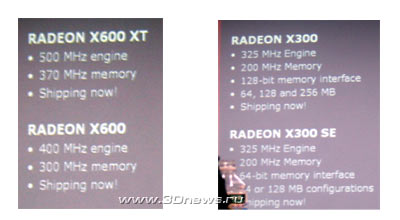
Even more, we expected that the screening after manufacture of X800 would be used in the X600 series, but no - they are different chips. Let it be that way, but then X600 and X300 sure should be of a unified chip differing in the frequencies only. X300 proved to be a standalone project; even more than that - the industry's first product manufactured using the 0.11 mk process technology: 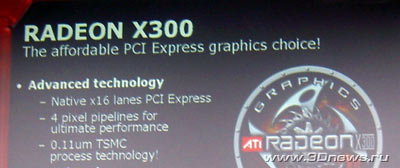
ATI first introduced the 0.13 mk process with the mainstream Radeon9600, and transition to the 0.11 was made for the lower-ends. That makes sense - X300 is much cheaper to produce, the number of chips to use is going to be very(!) high (Intel is full of confidence in migrating us all to new platforms in no time), because transition to new process technologies gives a 20% gain in the wafer area with greater chip yield. All seems to be logical enough.
Look at the left-hand card - it is the PCI-Ex version of X800XT, almost unique around the whole expo :) Strikingly, I wonder how many chips ATI is having now in the production! They have firmly stepped onto the path of native support for the new bus, and AGP versions and PCI-Ex versions are absolutely different. What a mess! This is even worse if we add mobile graphics, professional FireGL series, chipsets, telephone chips, and the yet indistinct chip for XBox2 with chips for high-precision TVs. It's high time we cut a foundation trench for our own lithographic production - there will be more than enough orders. If not enough - NVIDIA might help :)
"Standard" AGP X800XT/Pro. The Pro version has already hit the retail, at least in Taipei. 
The local NT currency exchange rate in Taiwan is equal to that of ruble-to-US dollar (1$=32 NT). To be more precise, it's a bit cheaper in rubles, but anyway it doesn't fall within the promised $300. AX800Pro is just like ASUS's - it is traditionally a bit costly than the lower item highlighted in red. It happened that the Pro cards occupy the market niche of XT cards while they haven't yet been released. On seeing NV40 we fainted! Has it really come true? At least at 22,500 rubles: 
The sales assistant showed us an empty box and asked to come back the other day :( Not even tomorrow, nor even on the day after tomorrow... The card is still not there, maybe it's there in Japan. Japan and USA are the most important markets, so they get the fresh creams. If my memory serves me right, the NV40 was announced on 12 April or so. Isn't two months a long while? ATI X800Pro was announced on 4 May and it's available everywhere by now: For pure curiosity and to keep myself fit, I'd rather walk to the market every morning until I finally get the niceties like these:
Of course it's cheaper to get to ASUS by taxi, but there isn't much fun and excitement in that. If you look at the Ultra specimen closer, you see that it offers one slot unlike the reference. Plus a backlit cooler. The card itself is likely to be the reference as all others are, but it looks like it was essentially revamped. Starting with GeForce 6800, the cards will be of own production, as is seen from the PCB color and the look of the cooler - the manufacturers thus accentuate the brand-awareness and continuity. Just take a look at ASUS GeForce 6800 and you won't take it for something different. By the way, it doesn't have any additional power connectors. The PCI-Ex has enough power. Only true monsters of the industry can afford to take liberties of creating own PCB for GeForce 6800 Ultra or X800 XT - these products are too complicated, and their sales amounts will be paltry to arrange production process at tens of enterprises. ATI and NVIDIA themselves place their production with partners. There are exceptions, although very rare. We already wrote in the news about Gigabyte's development of own card for GeForce 6800 Ultra (NV40): But at the company's expo stand there is still a standard top-end card built on the NVIDIA chip
The right-hand, non-ultra version, is already the company's own. Like at ASUS's expo stand, there was no interim GT version, although both companies promised to produce it. The GT is 16 pipelines albeit with reduced clock speeds of the core and memory (350/1000Mhz). Doesn't make sense dumping the chips whose all the 16 pipelines were operative albeit did not reach the intended frequencies... But all this is simply exotics to demonstrate the technological advancements of the industry. For common people, there are different, quite fresh lines of PCI-Ex video cards: To be more precise, they were "fresh" still at CeBit 2004 - who knew that Intel would delay the launch of Grantsdale for so long... The frequencies of these cards are absolutely standard - after all, these are full analogs of their AGP brothers with the PCI-Ex bridge added. That is, even in theory the use of PCI-Ex cards won't give any boost. The purpose of their release is to provide the market with cards of new standard - just to have something to insert into the new bus. ATI followed a different path and released new chips for the PCI-Ex, namely, X600 and X300: Gigabyte's ATI X300 will be released in the SE version - with 64-bit memory, although the chip supports 256-bit memory architecture. Such little ones are not bought for games, just on the contrary - to prevent employees from playing games at their workplaces :-) Mr. Tismer, a chief of Gainward German branch, once got offended at me so much that since then hasn't offered his hand to me. So much the worse for him :) But they really are able making video cards for true enthusiasts. At Computex`2004, Gainward decided not to build walls of their boxes and awards the way they normally did, but simply showed the cards, which is out of the ordinary. There is really something worth looking at: This is one of the few existing to date GeForce6800 Ultra video cards equipped with own original cooling system. The board itself is reference. But the card looks smarter even in the "one-storeyed" make, which is really nice. Then there go miracles: It's impossible to figure out the naming of these video cards. Gainward adores putting the labels "Golden Sample", "Ultra" and "PowerPack!" wherever needed or not. In short, if we can't understand the right marketing names of the product, the company seems to be in trouble because of the marketing, and something has to be changed about it. In fact, these are first steps of NVIDIA partners in creating "nonconventional solutions". Later on, they will be more than enough, but for now Gainward is ahead of the whole planet due to the release of GeForce6800 made in 128 and 256Mb makes on the base of regular DDR. Most likely, the memory used is the fastest possible - otherwise, there wouldn't have been much sense in all that. The PCB for Non-Ultra GeForce 6800 is a bit simpler, its 10-layered wiring is sufficient (unlike the 12-layered on the Ultra), and with time there will be numerous variations. What matters is that the stability of the board and the quality of components not suffer in the struggle for making the production cheaper. Another novelty from Gainward - the noiseless FX 5700 Ultra AGP: For the PCI-Ex sector, there is its own GeForce PCX 5900: A traditional fun at expos - taking pictures of those ladies at the expo stands ;) They bring in a pleasant atmosphere to the whole event and some special Asian charm.. I must admit, you'll never come across such cuties in the streets - all the local agencies made their best and gathered absolutely all what's charming in the country, or perhaps engaged a whole company of models from Hong Kong. For the exhausted IT folks it's just up to the mark! Just to make them recall more often about the usual pleasures of life existing apart from the warm computer. Enjoy :-)
Let's first look at the expo stand of Thermaltake whose produce is widely known in Russia. But wide publicity is not equal to wide popularity: in our tests we repeatedly mentioned the high noise levels and the high cost of the company products. To date, engineers at Thermaltake have attempted to overcome one of these shortcomings: a series of fully noiseless components will be presented for the public verdict. Here is the first of them: a radiator for cooling the CPU, dubbed Fanless 103. 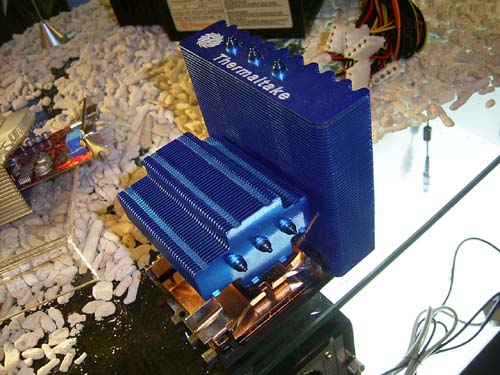
The radiator offers the most advanced design: the copper base and a great many of aluminum plates. Several heat pipes are used for joining. 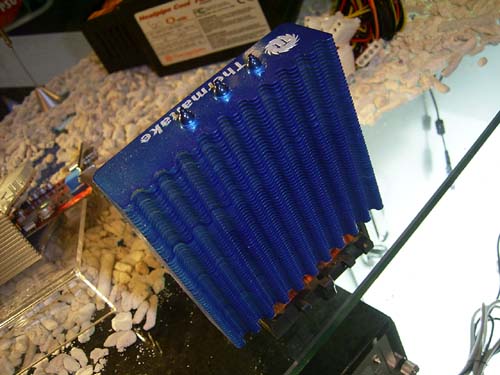
The product is aimed at Pentium4 and Athlon64 systems; has the dimensions 105х95х138 mm and weighs 752 g. 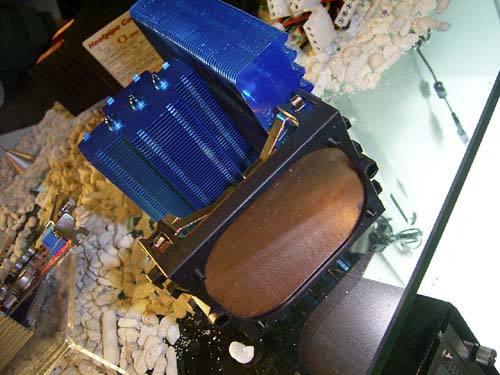
Clearly, the cooling of the processor with Fanless 103 will be effective provided air inside the housing does circulate. This means the need for additional fans. Besides, there is a need for active air circulation if a noiseless Fanless PowerSupply is installed. 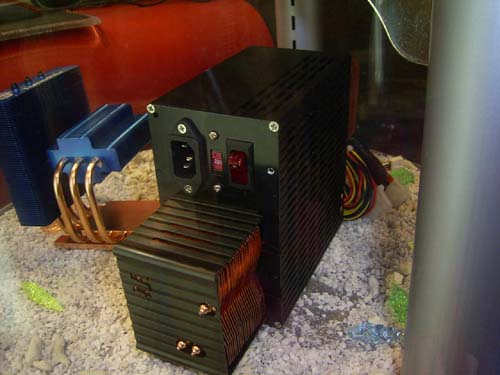
The heat generated by the power supply is carried off with heat pipes to two radiators: one of them installed inside the PC housing, with the other outside. 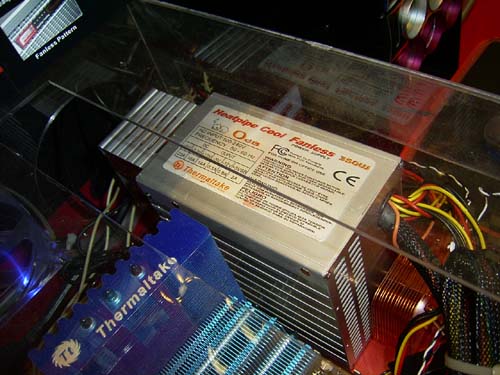
Finally, Thermaltake offered the noiseless Fanless VGA solution for cooling the video card. This is somehow modified Giant II cooler of which only the radiator is left. 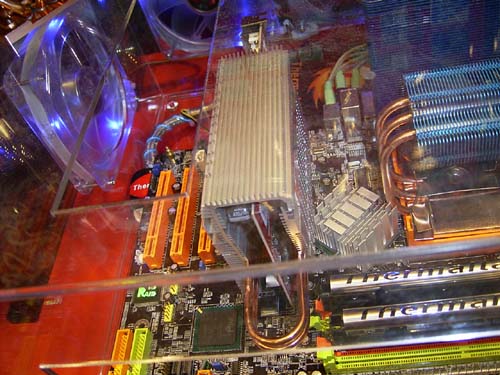
It is easy to see that improving the heat transfer, the company engineers installed two heat pipes instead of one. Another novelty - BigWater water-cooling system. 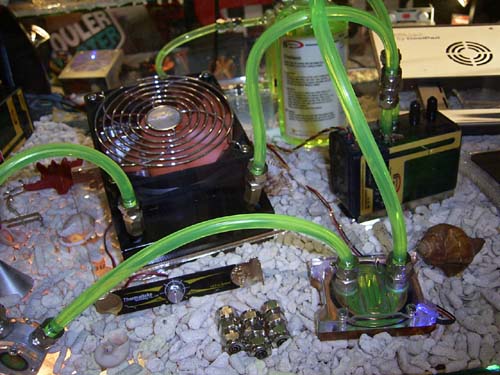
From the wide-spread Aquarius II, this system differs by its more massive radiator with a 120 mm radiator installed on top (80 mm - on Aquarius II), by more powerful pump, and the different design of the water black with a transparent lid. Bigwater is supplied with optional water block for a video card. In fact, it sells as a standalone product compatible to all H2O systems by Thermaltake. 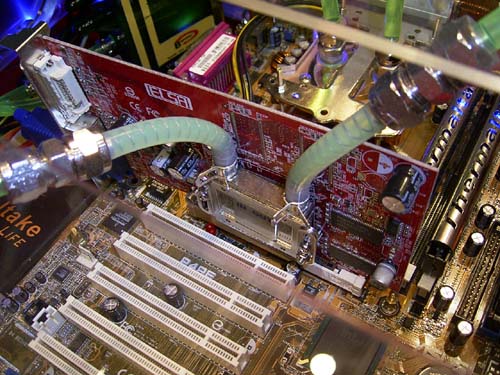
On the whole, new Thermaltake products produces quite a good impression. The final word will be pronounced by the pricing policy of the company, which unfortunately has never been democratic :). Cooler Master presented quite an impressive Hyper6 cooler. 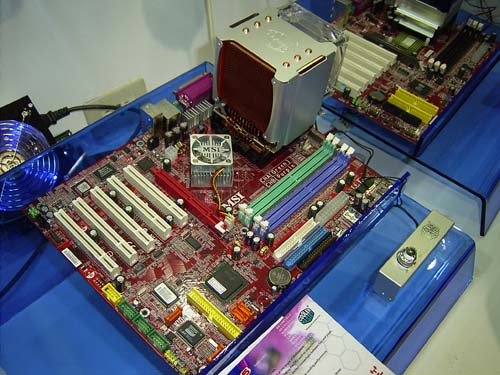
Actually, this is no longer a novelty - it was first demonstrated at CeBIT 2004. 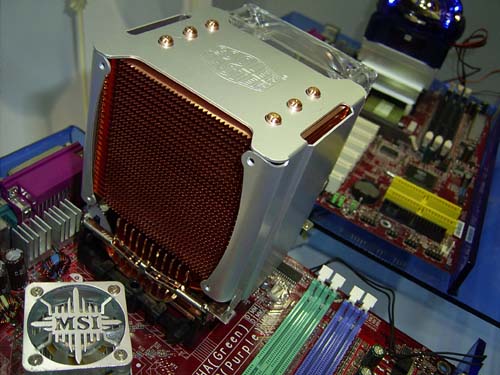
But the next cooler - Ultra Vortex - is demonstrated for the first time. 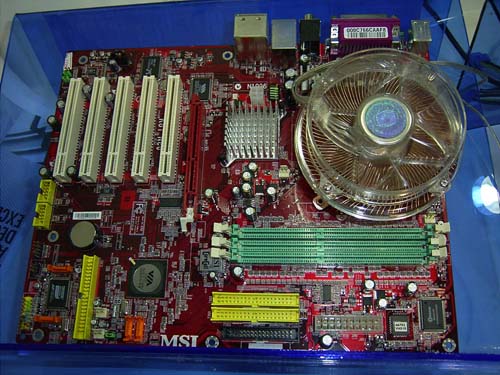 This cooler is compatible to Pentium4 and Athlon64 platforms, offers fully copper radiator and a very quiet fan (at the minimum speed, it is fully noiseless - 16dBa). 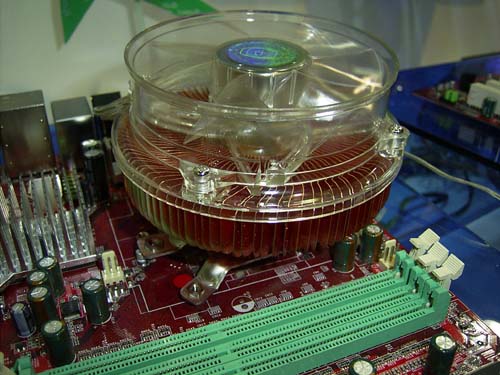
The cooler weighs 868 g, which certainly make the users handle the PC housing more carefully :). Another quite interesting exhibit is Aquagate water-cooling system. 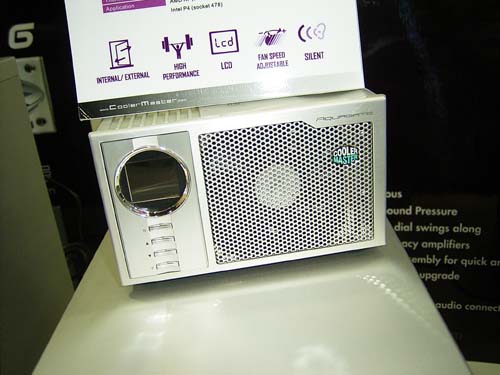
The specific feature of the system is its small bulk: it easily fits within two 5" compartments, as well as a LCD display for system monitoring. Then, the water block is made of copper, with its upper transparent part made of acryl. 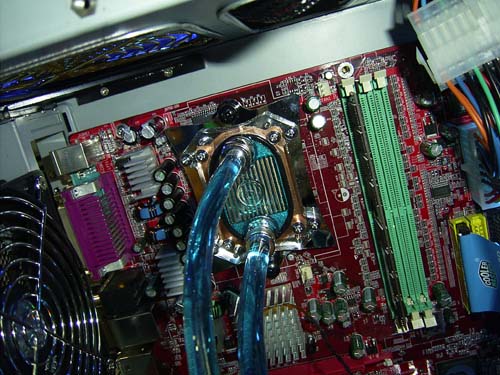
On the whole, Aquagate is a very interesting product which will certainly appeal to the PC enthusiasts. 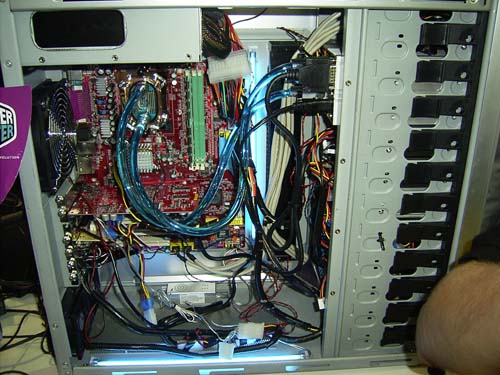
At the CoolerMaster expo stand you could see a great number of various 5" panels. 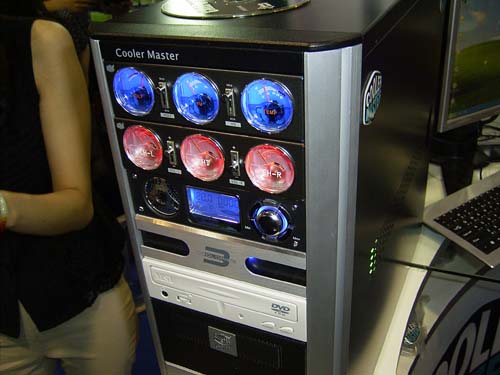
These are mainly various modifications of Musketeer and AeroGate panels. Although the expo stand of Zalman took up pretty much space, we walked it throughout in a few minutes. Most products exhibited were the same as those at CeBIT'2004. The only new product was external power supply unit NEPS 400. 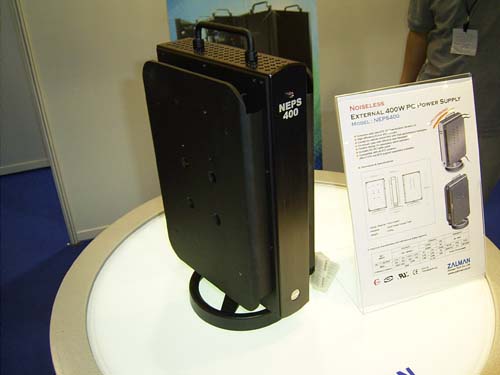
Its power was 400W, with the dimensions 220x162x360 mm. The specific feature of the PSU was its complete quietness: the housing is all single big radiator with which the heat is carried off. Besides, on the edges of the housing there are two "wings" which increase the surface area (thus the cooling efficiency) considerably. As a result, the company engineers found it possible to completely remove the fans. On the last day of the expo I returned to Zalman stand with the question: "Where are novelties?" To that the company representative showed me a Zalman 7700Cu cooler: 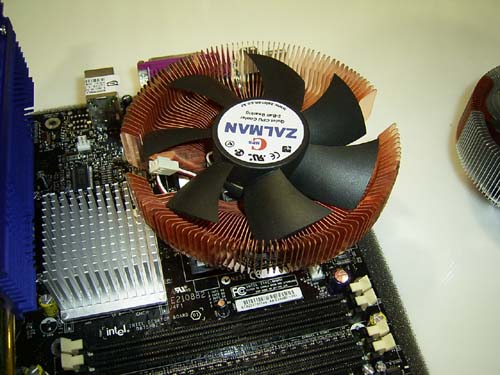
The cooler resembles Zalman 7000A-Cu like two peas,which was repeatedly tested in our test lab. But only when we placed the two coolers one beside another, the visual differences proved evident: 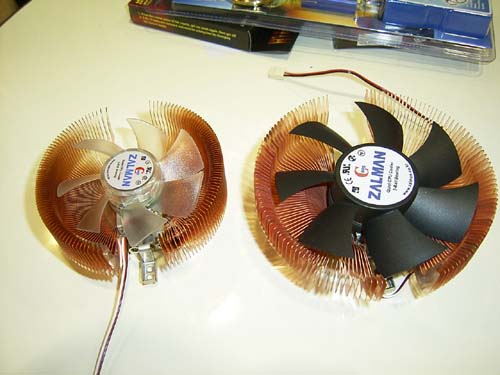 Zalman 7000A-Cu to the left, Zalman 7700Cu to the right 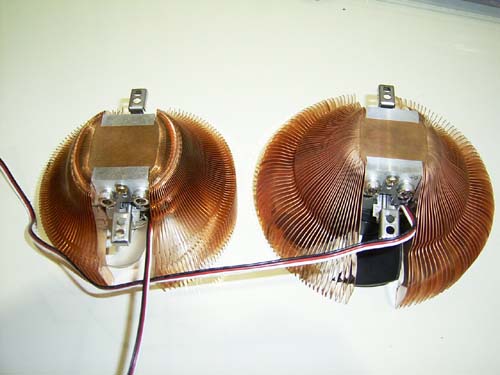
Once again, the company engineers increased the radiator dimensions, replaced the fan with a more massive one - 120 mm (on the 7000A-Cu model, there is a 92 mm fan). The most powerful and efficient motherboard (and thus must be the most expensive) in Abit's assortment is the AA8 DuraMAX model which yesterday arrived at our test lab, and soon we're publishing a full-featured review: 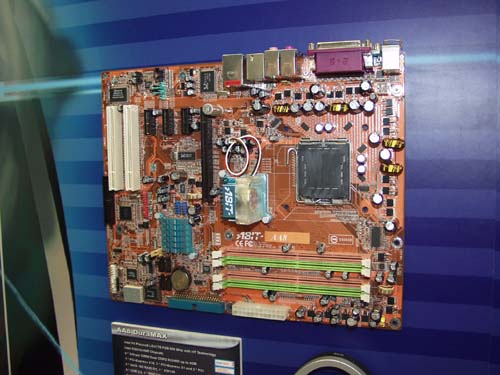
It is built on the i925X chipset, with the ICH6R used as the south bridge. The board offers the following specifications:
Frankly, compared to the top-end models by Asus and Gigabyte, this board looks quite mean. The competitor products offer wider choice of expansion options (e.g., two Gigabit LAN controllers, greater number of SerialATA channels (up to 8), support for Firewire-800, etc.). The following two motherboards are built on the i915P chipset and made on the same PCB design. The boards are called AG8 Pro and AG8. The former is more "advanced": it offers support for the DDR2 memory, whereas the the AG8 is aimed at using with the DDR memory. 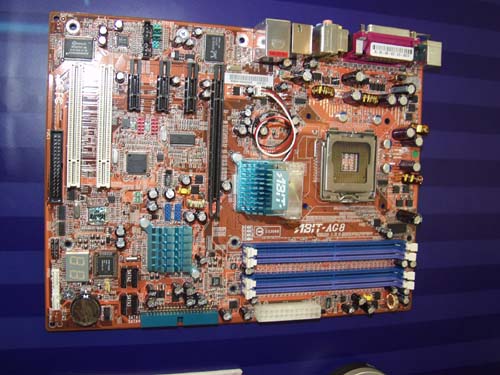
Note that Abit decided not to develop a board with simultaneous support for DDR and DDR2 - Intel warns it won't be responsible for unstable operation of such boards. But the company engineers invented quite a tricky thing: Guru Clock. This is an external LCD where various system information is displayed (temperature of the processor, system, environment, processor's clock speed, voltage levels, time etc.). Besides, the device can give warning of a newly arrived email or Windows Messenger message. 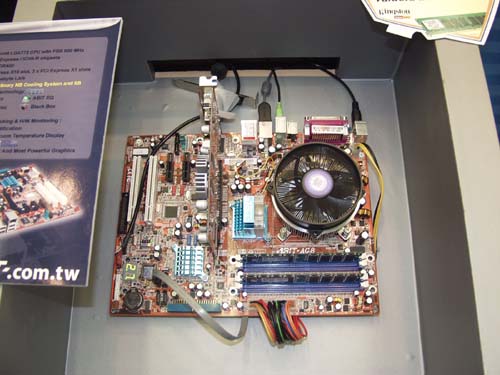
The Guru Clock can also control the processor's clock speed, i.e. overclock the system without entering the BIOS settings, or the OC Guru utility. By the way, the overclocking utility Abit OC Guru has acquired the additional feature - AutoDrive. This is another version of "dynamic overclocking", which allows increasing the system performance as load to the processor goes up. 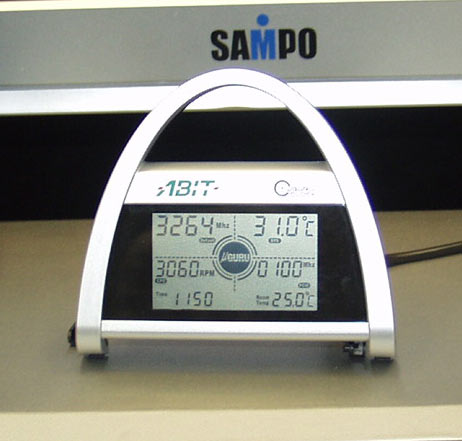
The next board is AS8. It features in that it is built on the i865PE chipset + ICH5R, but supports Socket LGA775 processors. 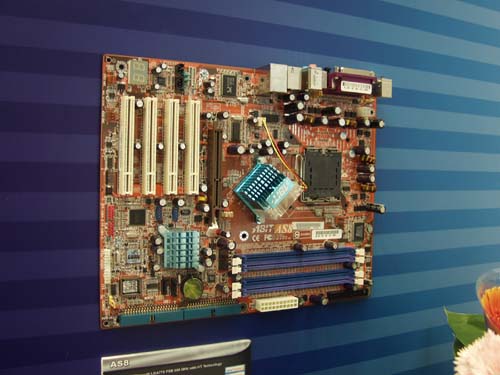
This product is ideal for users who have a powerful AGP video card and high-quality DDR memory, and intend to migrate to the LGA775 at minimum cost. Remember that when migrating to the i925X\i915P the video card has got to be replaced (with PCI Express only), the same applies to memory (only DDR2 for i925X, and i915P for some models). Now let's see what Abit offers to those users who are unwilling to deal with a brittle processor socket and the fire-spitting Prescott. I mean motherboards for AMD processors. 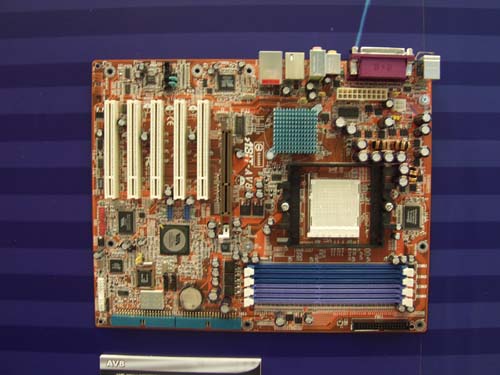 The flagship AMD model is Abit AV8 aimed at Athlon64 Socket939 processors. Here are the brief specifications:
For Socket754 processors, Abit offers KV8 Pro which is also built in the VIA K8T800 Pro chipset + VT8237: 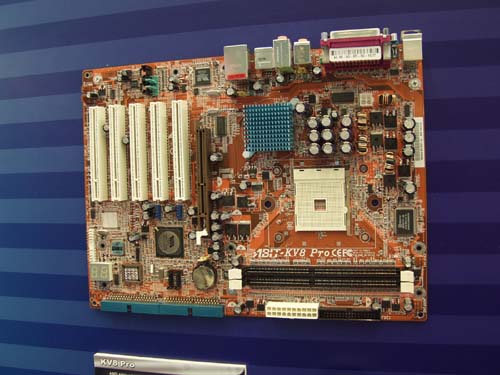
In fact, this board offers the same specifications as AV8, except the DIMM slots. They are merely two, since the integrated memory controller in Socket754 processors is single-channel. The next board is aimed at the fading SocketA market. This is Abit KV7 II based on the dual-channel VIA KT880+ VT8237 chipset. 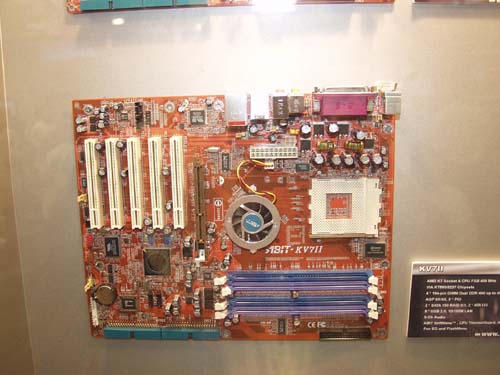 The inquisitive reader might ask - "Where on earth are motherboards on nVidia chipsets???" For example, на nForce3 1500; CK804". There aren't. Half a year ago, the situation didn't cause any questions: for a small quantity of little promising Athlon64 Socket754 processors, each second-rank manufacturer produced a motherboard. As the chipsets, the nForce3 150 or VIA K8T800 were used. However, sales of Athlon64 are gaining pace (especially, after the release of 2800+), and the lack of interesting (in terms of overclocking) motherboards built on nForce3 250 arouses questions. The situation turned more entangled after Abit's official announcement of poor stability of the nForce3 250 chipset. In fact, high politics may have been involved in that: in due time, Abit quite seriously quarreled with nVidia and even ceased production of video cards on NVIDIA chips, and now the latter has reduced supply volumes of the most recent chipsets. Anyway, the situation absolutely doesn't relate to the nVidia nForce2 400 Ultra chipset which acquired the new Gigabit MCP south bridge. Based on this combination, Abit designed the NF7 S2G motherboard. 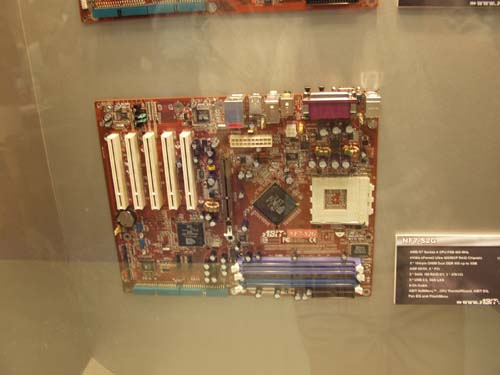
In conclusion, I'd like to note that I like Abit's expo stand most. It was put up away from the major visitor flows and designed in a very smart way. What matters is that I could easily find out what I wanted in the quiet atmosphere using my native Russian :)))  Vika (Abit Taiwan) MSI presented a new version of its motherboard built on the i925X chipset. This is the 925X Neo Platinum model which offers practically standard specifications: four DIMM slots with support for DDR2, one PCI x16 Express slot for most recent video cards, two PCI x1 Express slots, three PCI slots, eight USB2.0 ports, Gigabit Ethernet and four SerialATA channels (available are RAID arrays of levels 0, 1 and 0+1). Of additional features, worth mentioning is support for the Firewire (3 ports) as well as dual-channel ParallelATARAID. Interestingly, both additional controllers are made by VIA. 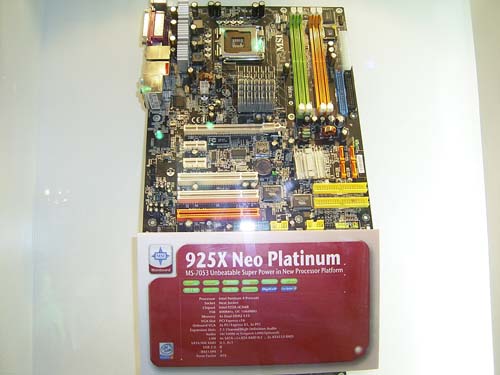
Besides, the board offers the CoreCell chip that expands the functionalities. Also declared is support for the faster bus of 1066 MHz speed. Remember that officially the i925X chipset supports processors with such bus. However, there are no visible obstacles to that, and the vast majority of boards should run correctly in this mode. The next quite interesting product is the 915P Combo motherboard which is built on the i915P chipset and supports both memory types (DDR and DDR2). 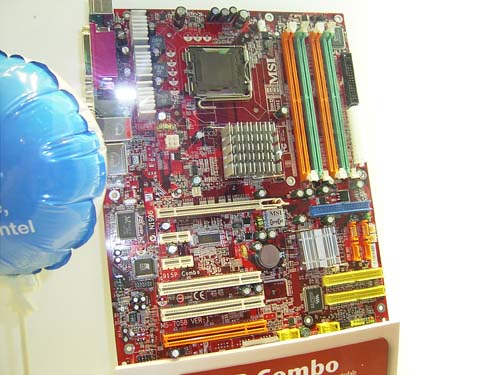
By its specifications, the board is a complete replica of 925X Neo Platinum. Now let's look at motherboards for AMD processors. First off, it is the K8N Platinum model which is aimed at Athlon64 Socket754 processors. This board is built on the nForce3 250Gb chipset and offers a peculiar PCB design (especially the positioning of DIMM slots). On the whole, relationships of MSI with nVidia are good enough (remember that MSI was one of the last to launch production of video cards on ATI chips), and it has not problems with supplies of various nForce3 versions. 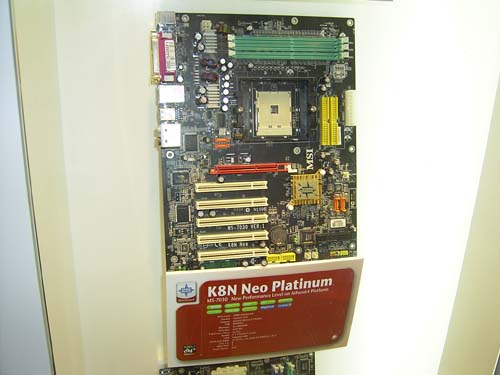
One more motherboard is also based on the nVidia chipset. This is K8N Neo2 Platinum based on the nForce3 Ultra chipset aimed at Athlon64 Socket939 processors. 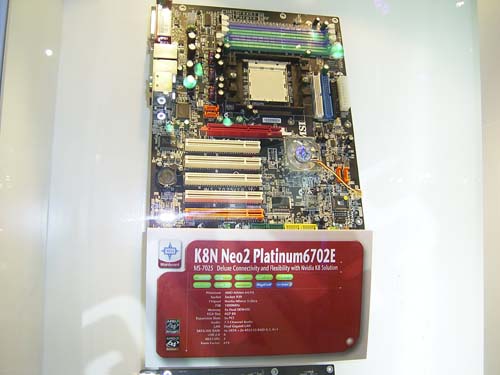
Since MSI is a first-rank company, it offers a motherboard on the VIA chipset in its assortment as well. Here is the K8T Neo2 model based on the VIA K8T800 Pro chipset also aimed at Athlon64 Socket939 processors. 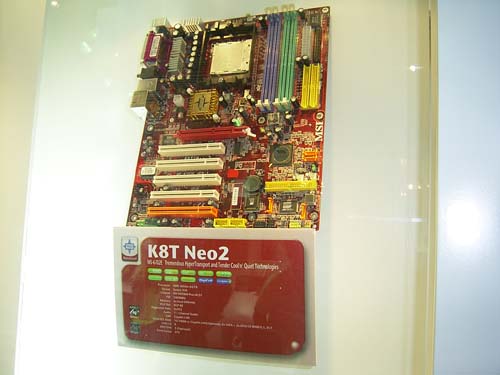 Finally, as a tribute to the fading era of SocketA, MSI presented the K7N2 Delta2 Platinum motherboard based on the nForce2 400 Ultra chipset + Gigabit MCP. 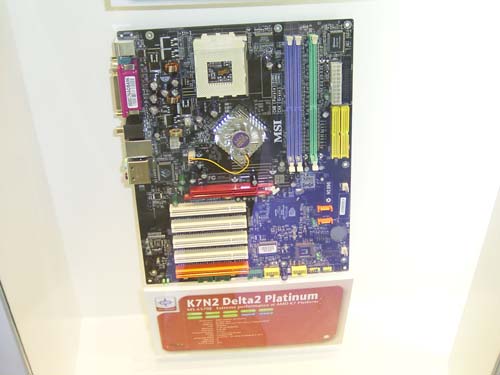
FoxconnFoxconn is known more as one of the largest OEM manufacturer of components. Prevailing in its assortment are LGA775 sockets (made by order from Intel), VGA, DVI patch plugs of all standards, and all the other plastic bijouterie used for the manufacture of motherboards. So the rumors of emerging the company on the retail market were taken with great surprise. The thing is, the profits made on the motherboard market is not large enough (this is not high-end products at a price about ~200$), and there are few incentives to get involved in the business. 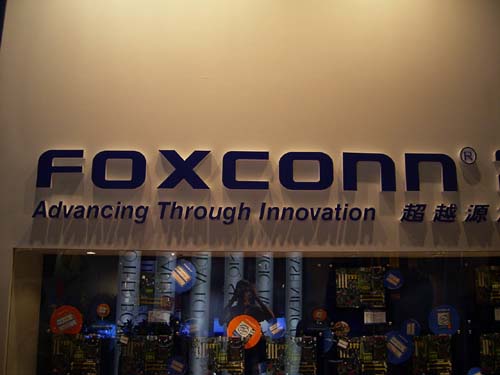
In any case, we did visit the expo stand of Foxconn and familiarized ourselves with the company assortment. That was first the 925A01 model based on the i925X chipset. 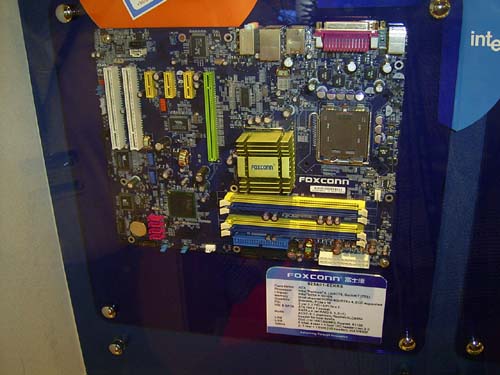
Here are the brief specifications:
The other two boards are built on the same PCD design but differ only in the chipset: the 915A03-P model is based on the i915P chipset, 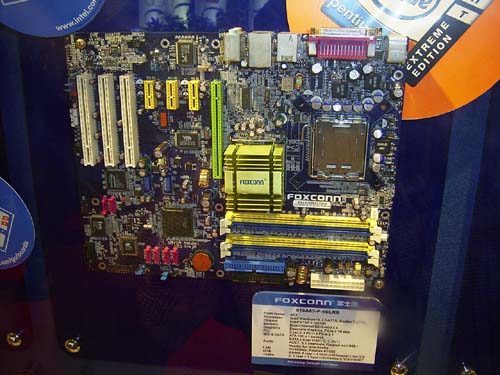
whereas the 915A03-G model is built on the i915G chipset with integrated graphics core. 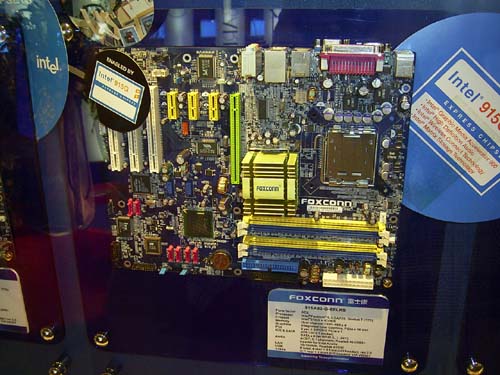
Both boards are intended for joint use with the DDR memory. Also note that both the boards offer six SerialATA channels each (which is greater than on the 925A01). Besides, we saw various micro-ATX boards at the stand, as well as boards for barebone systems. For example, the 915P01-G model on the i915P chipset. 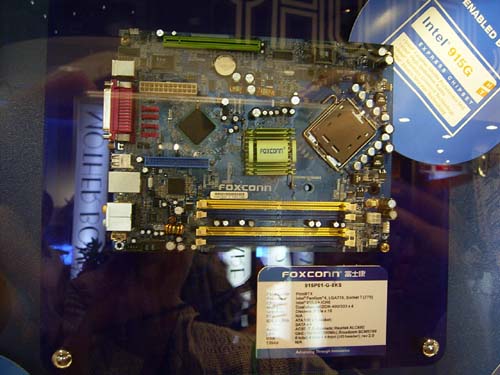
As regards motherboards for AMD processors, they were not there at the stand. |
|
|||||